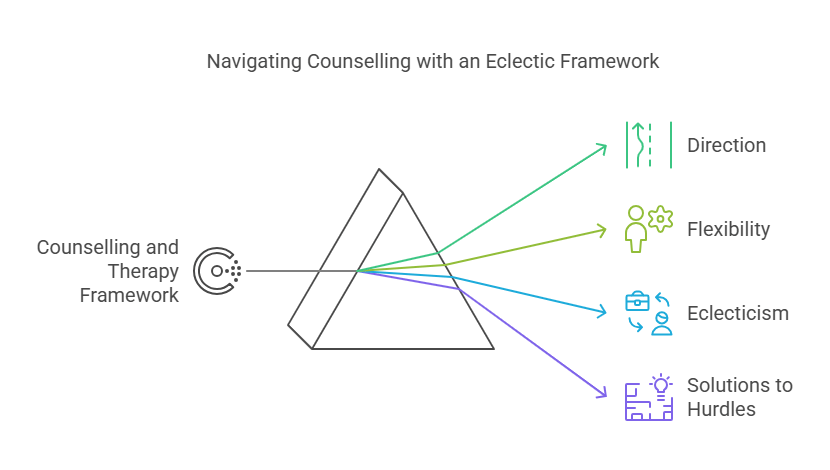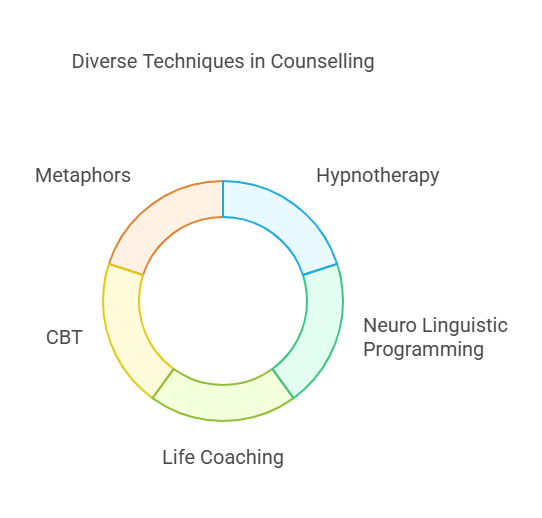Many counsellors and therapists that we mentor, frequently ask us about the steps in counselling or therapy that we follow with our clients. Most of these practitioners are looking for a framework that can provide them with a structure or step-by-step process that they can follow with their clients.
So in this post, I am sharing the steps that we follow and recommend in counselling sessions. Since we follow an eclectic approach, these steps are also very useful for those exploring eclectic therapy.
It is important to remember, therapy/counselling is very contextual and not everything mentioned can be applied as it is. Kindly use the steps suggested as a framework and make the necessary changes based on the requirements of the case.

Comprehensive framework for counselling and therapy
The key to having a good framework is that it needs to give us a sense of direction and yet be flexible to accommodate the uniqueness of clients experiences. It needs to be eclectic and should include solutions to possible hurdles that a counsellor or a therapist may face while working with a client.
Recommended Steps in Counselling

- Building Rapport:
- The basics: Dressing, Clinic Space, Cleanliness…
- Initial chit chat
- Getting and maintaining the state of Empathy (good to have this state anchored)
- Pacing & Leading (body language, tonality and choice of words)
- Client information sheet
- Defining the problem
S from SOFT SEA – Coaching Model*- Behaviour
- Emotions
- Triggers In case the client is not able to define the problem clearly, one of the steps in counselling will be to use meta model questions or abstract metaphors to assist the client.
- Reframing Problem:
Use Content or context reframing – (NLP Meta Model) - Identifying the Outcome & Defining Future:
O & F from SOFT SEA – Coaching Model- Sensory specific
- Behaviours
- Emotions or State
- Required Skills If the client is not able to describe the outcome, use transformational metaphor process to assist the client.
- Task list or Plan of Action:
T from SOFT SEA – Coaching Model.
If the client is not able to describe any conscious steps, use the revelation, introspection or transformational metaphor process to assist the client. - Finding the motivation which will drive the client towards the solution:
(NLP Core State can be used) - Getting a deeper understanding of the problem
- Undesired emotion attached to the problem (Interview)
- Any thought pattern or image (strategy) that is stuck in the clients mind. (T.O.T.E, Submodalities)
- Identify the root cause if required (Corrective therapy, EET, SVIT™, Void…)
- Is there something that the client can learn from the problem (Regression, Meta Model, Perceptual Position, Levels of transformation, Paris Window, Revelation Metaphor….)
- Identifying Positive intention or Secondary gain (Unconscious Talk, Meta Model)
- Past experiences leading to patterns (Interview, Meta Model, Regression)
- Creating Change / Resolving Problem
- Inducing a trance
- Helping clients let go of –ve emotions (hypnodrama, balloon, regression therapy, EET, metaphor…..)
- Alternate behaviours to fulfil positive intention or secondary gain (N-step reframing, parts integration, Cognitive interview, levels of transformation)
- Changing unresourceful strategies or patterns (Chain anchors, Fast phobia, submodalities…….)
- Developing required skills (Anchoring, Future pacing & real life practice)
- Application of skills towards desired behaviour / (s) to apply the learning’s or to achieve secondary gain contextually (Anchoring, Future pacing & real life practice)
- Review & Follow up
Steps in counselling will be incomplete without review and followup. Review and follow up happens at the start of each session. At the end of each session the client is also given some homework which may include:- Maintaining thought dairy
- Certain behavioural experiments
- Self Suggestions
- Listening to Recording
- Self-Hypnosis
- Other change processes
Remember not every step in the framework is required in all counselling cases. Also, the sequencing of the steps may change on a case to case basis.
Steps in counselling based on an Eclectic Approach

The techniques mentioned with each step belong to one of the following modalities:
These steps also incorporate principles from different schools of psychology i.e. Cognitive, Behavioural, Humanistic and Psychodynamics.
*The SOFT SEA coaching model is developed by members of ICHARS team in a way that complements the process from Hypnosis, NLP, CBT and Metaphors completely and effectively.
All these modalities are covered as a part of our comprehensive program for mental health practitioners titled “Cognitive Hypnotic Psychotherapy™“. If you are a psychologist but don’t know about this program, you must really check it out.

